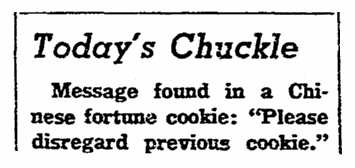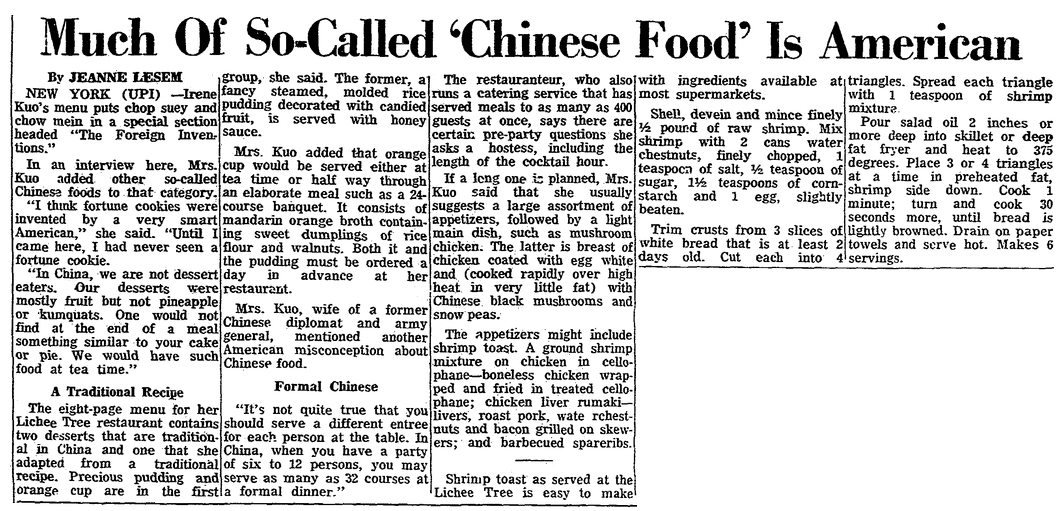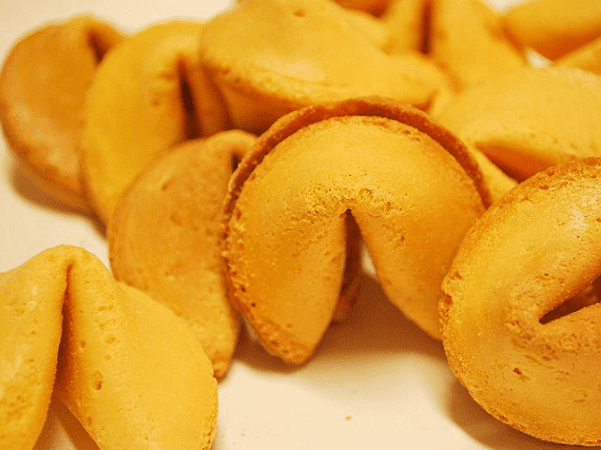Introduction: In this article, Gena Philibert-Ortega searches old newspapers to learn about the origin of Chinese fortune cookies – discovering that they are not Chinese at all, but an American innovation based on Japanese traditions. She includes some fortune cookie recipes. Gena is a genealogist and author of the book “From the Family Kitchen.”
Fortune cookies are as American as… well, apple pie. These bite-sized conclusions to a Chinese dinner are known for their wise (or not so wise) words to diners. So associated with the Chinese restaurant experience that they are even the object of jokes, fortune cookies have an interesting history – some of which you can find in the newspapers.

A History of the Fortune Cookie
Along with some other not so “traditional” Chinese foods, fortune cookies are not Chinese. Cookbook author Irene Kuo, who in the 1960s and 1970s was instrumental in promoting Chinese food in the United States, is interviewed in this 1966 newspaper article saying of the famous cookie’s origins:
“I think fortune cookies were invented by a very smart American… Until I came here, I had never seen a fortune cookie. In China, we are not dessert eaters. Our desserts were mostly fruit but not pineapple or kumquats. One would not find at the end of a meal something similar to your cake or pie. We would have such food at tea time.”

So, if fortune cookies are not Chinese – what are their origins? As a matter of fact, they have a Japanese origin by way of California! There are several claims to who the originator of the fortune cookie was.
One story credits Suyeichi Okamura, a Japanese immigrant who supplied fortune cookies to a San Francisco Japanese Tea Garden in 1906. Fortune cookies are a regional delicacy in Japan and are made with special molds that can be customized with initials, logos, or designs. Okamura continued making fortune cookies until World War II, when Japanese-Americans residing in California were forced to relocate to internment camps. It was then that Chinese businessmen started making the popular cookies.*
Recipes
In my opinion, fortune cookies are easier bought than made, but there are those more creative cooks who want to try their hand at the making, folding, and fortune writing that is required. This 1959 recipe, courtesy of a newspaper reader who lived in Hawaii, includes a surprising cookie ingredient: oats. Mrs. Dillon M. Pyron includes with the recipe a story of how she acquired it.
This 1968 recipe provides not only ingredients and cooking instructions, but illustrations for folding the fortune cookie. The “delicate, exotic flavor” that these cookies supposedly have most likely comes from the instant tea powder added to the dough.
Recipes sometimes change over time, and in the case of the fortune cookie, the list of ingredients became fewer – but that isn’t the only thing that changed. The fortunes themselves have changed over the generations to match current society moirés. Fortunes are a product of their time, and today’s fortune cookie writers are busy writing fortunes that appeal to today’s generation.
This 1987 newspaper article points out that sexist jokes or instructions to kiss your waitress were out and fortunes involving travel and adventure were in.
Fast forward to 2017 and the fortune cookies I recently bought reflect today’s world, with mentions of email, travel, stress relief, and how to be more efficient at work – as well as lucky lottery numbers.
May Your Fortune Come True
While your cookie fortune is unlikely to come true, they are still a fun way to end a meal. Do you have any fortune cookie stories? Have you tried to make fortune cookies at home? Tell us about it in the comments section below.
———————-
* “Origins of a Fortune Cookie,” Smithsonian (http://americanhistory.si.edu/blog/2010/07/origins-of-a-fortune-cookie.html : accessed 2 September 2017).
